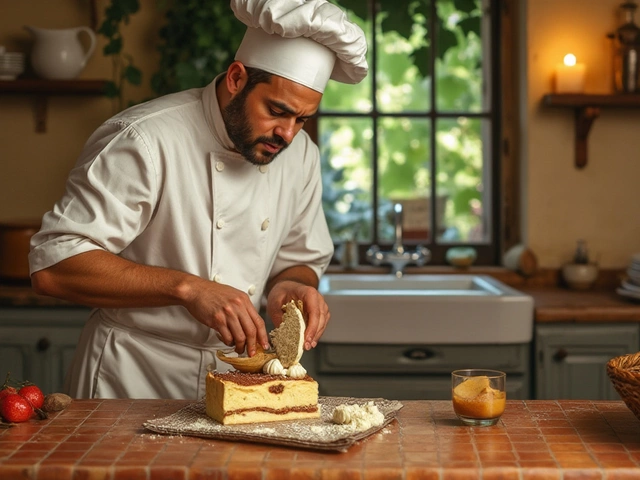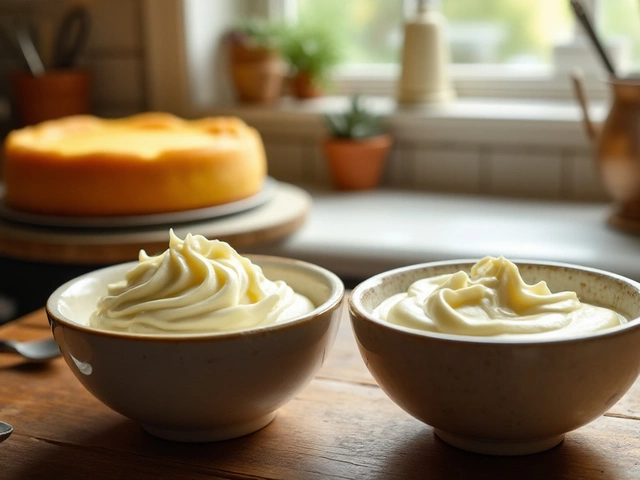
Tiramisù isn’t just a dessert—it’s a source of pride, drama, and even a little bit of scandal if you dig into its past. People argue over which corner of Italy gave the world this creamy coffee dream. Some say the Veneto region, while others shout for Friuli Venezia Giulia. There’s no easy answer, but there are some juicy stories to tell.
If you’re obsessed with making the real deal at home or just love a good food debate, knowing the backstory matters. The fight over tiramisù’s birthplace isn’t just an old chef’s tale; it actually ended up in legal battles, and even made headlines with family feuds over hidden recipes. So, next time you dig your spoon into that espresso-soaked layer, remember: you’re tasting a slice of history and maybe a bit of family drama, too!
- A Slice of Controversy: The Battle Over Tiramisù’s Birthplace
- Cafe Culture and the Dessert’s Rise to Fame
- What Makes Classic Tiramisù Truly Italian?
- Surprising Facts You Might Not Know
- Simple Tips for Authentic Homemade Tiramisù
A Slice of Controversy: The Battle Over Tiramisù’s Birthplace
Ask anyone in Italy about the tiramisù origin, and get ready for a serious debate. Two regions—Veneto and Friuli Venezia Giulia—claim to be the real home of this dish. The most famous story credits the city of Treviso, Veneto, where a small restaurant called Le Beccherie started serving tiramisù in the late 1960s. The owner’s wife, Alba Campeol, is often said to be the mastermind behind the first batch. Her family later went public with their traditional recipe, and local folks still swear by it.
But Friuli Venezia Giulia isn’t backing down. A restaurant in Tolmezzo argues that it served something called "Tiremesù"—almost the same dessert—years earlier in the 1950s. Some even point to an old menu as proof. It’s wild how this dessert is part of official paperwork: in 2017, Friuli Venezia Giulia made an official request for UEFA heritage recognition, hoping to stamp their official claim on tiramisù history.
Honestly, nobody can agree. Here’s a peek at the main claims:
- Le Beccherie, Treviso (Veneto): Popularized the iconic layered dessert in the 1960s. Their family recipe is still a hot topic.
- Ristorante Roma, Tolmezzo (Friuli Venezia Giulia): Showed off an old bill and menu from the 1950s with their version already on it.
You’d think this would get settled eventually, but the battle goes on. Italian food writers, chefs, and even politicians argue over this all the time. One thing’s for sure: whether you eat it in Treviso or Tolmezzo, you’ll get something deliciously creamy and caffeinated. And maybe a free history lesson from the locals if you ask about the Italian dessert’s roots.
Cafe Culture and the Dessert’s Rise to Fame
Back in the 1960s and '70s, Italian cafes were big on creating unique desserts to grab attention. Bars and trattorias in the Veneto region, especially in Treviso, started serving what we now call tiramisù as a sweet pick-me-up with afternoon coffee. People liked it because it felt fancy, but you didn’t need a chef’s hat to whip it up. Simple stuff—layered biscuits, sweet mascarpone, a shot of espresso, and a dusting of cocoa.
The earliest written recipes for this Italian dessert began popping up in restaurant menus around Treviso in the late seventies. Le Beccherie, a café in Treviso, put tiramisù front and center and claimed the title of “first to serve.” Suddenly, everyone wanted to add it to their own menus, and the dessert started spreading fast—not just across Italy, but throughout Europe and eventually the US.
With Italian coffee bars booming in popularity worldwide, tiramisù rode the wave. American restaurants caught on in the '80s, especially in New York and San Francisco, where Italian immigrants kept the recipe alive and kicking. It became a symbol of Italian comfort food—nothing complicated, just creamy, coffee-soaked goodness that made you want to order another slice.
Here’s a quick look at how tiramisù spread from small town treat to superstar:
- 1969: Le Beccherie in Treviso starts serving what locals call tiramisù.
- 1978: Regional cookbooks in Veneto list the dessert’s recipe.
- 1980s: Italian-American restaurants pick up tiramisù and make it trendy in the US.
- 1990s: Supermarkets in Europe and North America start selling ready-made versions.
By the 2000s, tiramisù could be found everywhere—from fancy restaurants to home kitchens and even as ice cream flavors. The café culture that shaped tiramisù’s fate stuck: people still order it with coffee, chat with friends, and turn dessert into a mini event.
If you love a dessert with history and a side of coffee, tiramisù is the poster child. No wonder it’s still grabbing headlines and fueling dessert debates!

What Makes Classic Tiramisù Truly Italian?
At first glance, tiramisù might look like a simple layered dessert. But Italians swear by a few rules if you want to call it the real deal. Let’s break it down:
- Only a handful of ingredients are allowed: Authentic tiramisù is made from ladyfingers (savoiardi), eggs, sugar, mascarpone cheese, espresso, and cocoa powder. No whipped cream or weird liqueurs if you want Italian approval.
- No baking involved: It’s all about chilling. The ingredients are gently mixed and layered, then left to set in the fridge. The cool, creamy texture comes from patience, not an oven.
- Espresso matters: Not just any coffee—real Italian espresso gives that deep, bold flavor. Weak American coffee? Italians would shake their heads!
- Fresh eggs, always raw: Some people get nervous about raw eggs. But the traditional method skips cooking. It’s part of why tiramisù tastes so rich (but, yeah, buy pasteurized eggs if you’re worried).
Want to see just how consistent classic recipes are? Check this:
| Ingredient | Common Italian Portion |
|---|---|
| Mascarpone | 500g |
| Eggs | 5 (yolks used) |
| Sugar | 100g |
| Savoiardi | 300g |
| Espresso | 300ml |
| Cocoa powder | to dust |
You might see restaurants add things like fruit, chocolate chips, or even alcohol, but old-school Italians say that’s not real tiramisù. The beauty is in keeping it simple—just the basics, done right, coming together for that melt-in-your-mouth magic.
Surprising Facts You Might Not Know
Sure, you love tiramisù, but bet you didn’t know half the wild facts behind this iconic Italian dessert. Here’s what makes tiramisù more than just another sweet dish.
- Tiramisù isn’t really that old. Despite feeling super traditional, it only started showing up in Italian restaurants in the 1960s and 1970s. The first time tiramisù was mentioned in an official document was in 1980, when it popped up in a restaurant menu in Treviso.
- This dessert’s name literally means “pick me up” in Italian. Makes sense, right? Between all that coffee and sugar, it’s basically designed to wake you up after a big meal.
- There’s still a heated debate in Italy about whether you should use raw eggs. Some folks swear by the original recipe and wouldn’t dream of skipping them. Others worry about safety and use pasteurized eggs or skip them altogether.
- Mascarpone cheese wasn’t always easy to get outside Italy. For ages, people tried using regular cream cheese or custard when they couldn’t find it. Don’t let the purists catch you, though.
- People once believed tiramisù was invented for new moms, claiming it would give them energy while also being gentle on the stomach. Turns out, it was basically the first “energy dessert” before modern sports drinks came along.
| Year | Milestone |
|---|---|
| 1960s | Early versions of tiramisù show up in Northern Italy |
| 1980 | First appearance on a written menu (Le Beccherie, Treviso) |
| 2017 | Tiramisu Day established in Italy (March 21st) |
Lastly, there are now tiramisù competitions around Italy, with hundreds duking it out for the softest layers or the strongest coffee kick. If you ever head over during the annual Tiramisu Day, save room for some taste-testing. And yes, more than a hundred variations exist today—from strawberry versions to vegan spins. There’s a tiramisù for just about everyone.

Simple Tips for Authentic Homemade Tiramisù
If you want to make truly authentic tiramisù at home, skip the shortcuts and stick with the basics—just like in old Italian kitchens. The original recipe is all about a few simple ingredients and handling them right. Here’s what you need to know to get that perfect, creamy bite every single time.
- Use real mascarpone: Don’t swap it with cream cheese or some random substitute. Mascarpone is the secret to that silky, rich texture.
- Eggs should be fresh: Seriously, don’t mess around here. Italian nonnas swear by fresh, room-temperature eggs for both the yolks and the whites. Whenever possible, look for pasteurized eggs if you’re worried about safety.
- Espresso, not regular coffee: Traditional Italian tiramisù uses strong espresso for dipping the ladyfingers. If you only have drip coffee on hand, make it extra strong. Don’t use flavored or instant coffee—it throws off the classic flavor.
- Ladyfingers (savoiardi): The dry, crunchy ones are exactly what you want. Soft sponge cake just turns to mush. Dip them quickly in espresso—just a second or two—so they don’t fall apart in the pan.
- No whipped cream in the classic version: Even though a lot of recipes suggest folding in whipped cream, the original doesn’t use it. You get the creamy airiness from whipped egg whites instead.
- Cocoa powder on top: Use unsweetened cocoa only, and dust it on just before serving to keep it from turning soggy.
Want your tiramisù to taste like the best Italian cafés serve it? Here are some extra pro-tips:
- Let it chill in the fridge for at least 6 hours. Overnight is even better—those flavors need time to blend.
- Try adding a splash of Marsala or dark rum to the egg yolk mixture for that grown-up kick. A tablespoon is enough.
- Don’t overload with sugar. Traditional tiramisù isn’t overly sweet; the flavors should balance out, not just taste sugary.
| Ingredient | Origin | Must-Have? |
|---|---|---|
| Mascarpone | Italy | Absolutely |
| Savoiardi | Italy | Absolutely |
| Espresso | Italy | Absolutely |
| Eggs | Italy | Absolutely |
| Marsala (optional) | Italy | Recommended |
If you get these steps and ingredients right, you’ll end up with a diner-worthy tiramisù that’s as close as possible to what you’d get in a little café in Treviso. Don’t worry about being fancy—stick to the basics for that truly authentic bite.












Write a comment